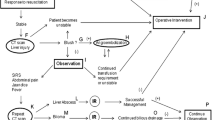Abstract
This study was designed to evaluate whether percutaneous injection of hemostatic agents under the guidance of contrast-enhanced ultrasound (CEUS) can stop hemorrhage from severe hepatic trauma. Eighteen dogs were impacted by a miniature impactor to create blunt hepatic trauma. Fourteen with appropriate liver lesions were divided into two groups: the treatment group (n = 7) and the control group (n = 7). In the treatment group, hemocoagulase atrox and α-cyanoacrylate were respectively injected into the injury sites and transected micro-vessels under the guidance of CEUS. In the control group, normal saline was injected into the injury sites. CEUS and CT were performed at 3, 7, 14, and 21 days after the focal injection. Surviving animals were killed on the 21st day for pathologic examination. All animals of the treatment group survived. Three dogs of the control group died in the first 24 h. In the treatment group, CEUS and CT demonstrated that hepatic lesions became smaller gradually from the 3rd to the 21st day after injection. The focal injection of hemostatic agents under the guidance of CEUS can stop hemorrhage from hepatic trauma of grade III~IV or IV. During the period of 3 weeks, no side effect was found.




Similar content being viewed by others
References
Mooney DP (2002) Multiple trauma: liver and spleen injury. Curr Opin Pediatr 14:482–485
Ochsner MG (2001) Factors of failure for nonoperative management of blunt liver and splenic injuries. World J Surg 25:1393–1396
Letoublon C, Arvieux C (2002) Nonoperative management of blunt hepatic trauma. Minerva Anestesiol 68:132–137
Moore EE, Cogbill TH, Jurkovich GJ et al (1995) Organ injury scaling: spleen and liver (1994 revision). J Trauma 38:323–324
Carrillo EH, Wohltmann C, Richardson JD et al (2001) Evolution in the treatment of complex blunt liver injuries. Curr Probl Surg 38:1–60
Trunkey DD (2004) Hepatic trauma: contemporary management. Surg Clin North Am 84:437–450
Galvan DA, Peitzman AB (2006) Failure of nonoperative management of abdominal solid organ injuries. Curr Opin Crit Care 12:590–594
Zyromski NJ, Lillemoe KD (2006) Current management of biliary leaks. Adv Surg 40:21–46
Thorelius L (2004) Contrast-enhanced ultrasound for extrahepatic lesions: preliminary experience. Eur J Radiol 51(Suppl):S31–S38
Catalano O, Cusati B, Nunziata A et al (2006) Active abdominal bleeding: contrast-enhanced sonography. Abdom Imaging 31:9–16
Catalano O, Lobianco R, Raso MM et al (2005) Blunt hepatic trauma: evaluation with contrast-enhanced sonography: sonographic findings and clinical application. J Ultrasound Med 24:299–310
Bahar I, Kaiserman I, Slomovic A et al (2007) Fibrin glue for opposing wound edges in “top hat” penetrating keratoplasty: a laboratory study. Cornea 26:1235–1238
Maluf Filho F, Sakai P, Ishioka S et al (2001) Endoscopic sclerosis versus cyanoacrylate endoscopic injection for the first episode of variceal bleeding: a prospective, controlled, and randomized study in Child-Pugh class C patients. Endoscopy 33:421–427
Greenwald BD, Caldwell SH, Hespenheide EE et al (2003) N-2-butyl-cyanoacrylate for bleeding gastric varices: a United States pilot study and cost analysis. Am J Gastroenterol 98:1982–1988
Li Z, Dong XZ, You FS et al (2006) Establishment of animal model of intraperitoneal bleeding in rabbits. Chinese Journal of Comparative Medicine 16:217–219
Holcomb JB, McClain JM, Pusateri AE et al (2000) Fibrin sealant foam sprayed directly on liver injuries decreases blood loss in resuscitated rats. J Trauma 49:246–250
Carrillo EH, Richardson JD (2001) The current management of hepatic trauma. Adv Surg 35:39–59
Goffette PP, Laterre PF (2002) Traumatic injuries: imaging and intervention in post-traumatic complications (delayed intervention). Eur Radiol 12:994–1021
Rogers CG, Knight V, MacUra KJ et al (2004) High-grade renal injuries in children–is conservative management possible? Urology 64:574–579
Raza SA, Walser E, Hernandez A et al (2006) Transhepatic puncture of portal and hepatic veins for TIPS using a single-needle pass under sonographic guidance. AJR Am J Roentgenol 187:W87–W91
Elgazzar RF, Addulmajeed I, Mutabbakani M (2007) Cyanoacrylate glue versus suture in peripheral nerve reanastomosis. Oral Surg Oral Med Oral Pathol Oral Radiol Endo 104:465–472
Canonico S, Campitiello F, Santoriello A et al (2001) Sutureless skin closure in varicose vein surgery: preliminary results. Dermatol Surg 27:306–308
Thabut D, Bernard Chabert B (2007) Management of acute bleeding from portal hypertension. Best Pract Res Clin Gastroenterol 21:19–29
Fotiadis C, Leventis I, Adamis S et al (2005) The use of isobutyl-cyanoacrylate as a tissue adhesive in abdominal surgery. Acta Chir Belg 105:392–396
Acknowledgement
The financial support of the Military Medical Science Program (no. 06G108) is gratefully acknowledged.
Author information
Authors and Affiliations
Corresponding author
Rights and permissions
About this article
Cite this article
Tang, J., Lv, F., Li, W. et al. Percutaneous injection of hemostatic agents for severe blunt hepatic trauma: an experimental study. Eur Radiol 18, 2848–2853 (2008). https://doi.org/10.1007/s00330-008-1096-5
Received:
Revised:
Accepted:
Published:
Issue Date:
DOI: https://doi.org/10.1007/s00330-008-1096-5




